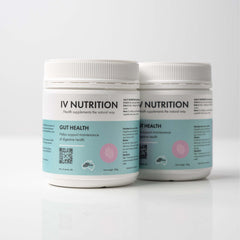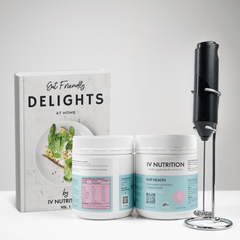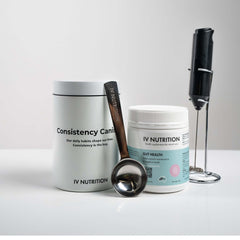Prebiotics vs. Probiotics: Which One Is Best for Me? A Science-Backed Guide to Choosing the Right Gut Support
We’ve all heard the buzzwords: prebiotics and probiotics. From yogurt commercials to supplement shelves, the world of gut health has never been more crowded—or more confusing.
So let’s get clinical (and a little cheeky): Prebiotics vs. Probiotics—Which one is best for me? That’s the gut-level question we’re answering today.
Whether you’re navigating bloating, irregular digestion, or simply trying to optimize your microbiome for better health, this in-depth guide will break down the difference between the two, what science says, and when each one shines.
And yes, we’ll also introduce you to a standout prebiotic fiber—IV Nutrition’s Virgin Manufactured Sugarcane Prebiotic Fiber—with a 100% free first tub offer if you subscribe (here’s the link).
Let’s get into it.
What’s the Difference Between Prebiotics and Probiotics?
Let’s start with definitions—because even though the words sound similar, they do very different things.
Probiotics: The “Good Bacteria”
Probiotics are live microorganisms (usually bacteria or yeasts) that, when consumed in adequate amounts, provide health benefits. They help restore or maintain the balance of microbes in your gut, especially after antibiotics, illness, or dietary disruption.
Common Probiotic Strains:
-
Lactobacillus acidophilus
-
Bifidobacterium bifidum
-
Saccharomyces boulardii (a yeast)
You’ll find them in:
-
Yogurt
-
Fermented foods like kimchi and sauerkraut
-
Kombucha
-
Probiotic supplements
Prebiotics: The Food for Your Gut Microbes
Prebiotics are non-digestible fibers and compounds that serve as food for your body’s beneficial bacteria. They stimulate the growth and activity of these microbes—especially in the large intestine.
Examples of Prebiotics:
-
Inulin
-
Fructooligosaccharides (FOS)
-
Galactooligosaccharides (GOS)
-
Resistant starch
-
Virgin sugarcane fiber (more on this later!)
Unlike probiotics, prebiotics are not alive—but they feed the good guys, helping them thrive.
A Quick Analogy: Garden Edition 🌱
Think of your gut like a garden:
-
Probiotics = Planting new seeds (live beneficial bacteria)
-
Prebiotics = Fertilizing the soil (feeding the beneficial bacteria you already have)
Both can support a healthy ecosystem—but if your soil’s depleted (hello poor diet, stress, and antibiotics), planting seeds won’t do much. You need to feed and nourish what’s already there.
What Does the Science Say?
Let’s dig into some peer-reviewed proof.
Probiotics: The Pros and Cons
Probiotics have been shown to:
-
Help restore gut flora after antibiotic use (PubMed Study)
-
Reduce diarrhea in cases of infection or medication use
-
Improve symptoms in some cases of IBS (Mayo Clinic)
But here’s the catch:
-
Many probiotics don’t survive stomach acid, meaning they never reach the intestines where they’re needed.
-
Benefits tend to be strain-specific—what works for one condition may not work for another.
-
Their effects are often temporary unless you keep taking them consistently.
In short: Probiotics can help, but they’re finicky and not always a one-size-fits-all solution.
Prebiotics: The Silent Superheroes
Unlike probiotics, prebiotics:
-
Are heat-stable and shelf-stable
-
Aren’t destroyed by stomach acid
-
Support your native microbiota, which is more diverse and personalized
-
Promote production of short-chain fatty acids (SCFAs) like butyrate, which reduce inflammation and protect gut lining integrity (Nutrients Journal)
One meta-analysis from Frontiers in Nutrition found that prebiotics significantly improved stool frequency, microbiota composition, and reduced markers of inflammation in both healthy individuals and those with GI disorders.
In other words: Prebiotics help create the right conditions for gut health, which makes probiotics (whether supplemented or naturally occurring) more effective.
So, Which One Is Best for You?
Let’s explore some common situations:
| Condition or Goal | Recommended | Why |
|---|---|---|
| Recently took antibiotics | Both | Probiotics can reintroduce bacteria; prebiotics help them establish |
| IBS or digestive discomfort | Prebiotics | More consistent improvement in symptoms and long-term balance |
| Constipation | Prebiotics | Help increase stool bulk and frequency |
| After stomach flu or GI infection | Probiotics | Can reduce duration of diarrhea (especially S. boulardii) |
| General gut health maintenance | Prebiotics | Feed your own unique, beneficial microbes for long-term resilience |
| Immune system support | Both | 70% of your immune system lives in the gut—support it from both angles |
| Bloating or sensitivity to fiber | Prebiotics (low and slow) | Gentle fibers like sugarcane prebiotic are less likely to cause issues |
Introducing the Underrated MVP: Sugarcane Prebiotic Fiber
If you’re new to prebiotics—or you’ve tried them before and didn’t love the results—this one’s for you.
IV Nutrition’s Virgin Manufactured Sugarcane Prebiotic Fiber is quickly gaining recognition in the clinical nutrition space for its simplicity, effectiveness, and gut gentleness.
What Makes It Special?
-
Derived from virgin-manufactured sugarcane fiber (not waste byproducts or harsh processing)
-
Completely plant-based and non-GMO
-
Rich in soluble, fermentable fibers that your beneficial bacteria love
-
No bloating, no sugar, no nonsense
It’s a gut gardener’s dream fertilizer—and it pairs beautifully with or without probiotics.
Bonus: Your First Tub Is FREE
Yep, free.
👉 Click here to claim your 100% off offer when you subscribe
How to Use Prebiotics and Probiotics Together
Want the best of both worlds? Here’s how to do it smartly:
1. Start with Prebiotics
Begin feeding your native microbes and improving gut environment. Start with:
-
½ scoop of sugarcane prebiotic fiber
-
Mix in water, smoothies, or yogurt
-
Use daily
2. Introduce Probiotics (Optional)
If you’re taking probiotics, choose:
-
Strain-specific products (L. rhamnosus GG, B. lactis, or S. boulardii)
-
Refrigerated or shelf-stable options with guaranteed live cultures
-
Avoid "mega doses" with 20+ strains—it’s not always better
3. Be Consistent
The microbiome takes time to shift. Give your routine 4–6 weeks and track symptoms in a gut journal.
Common Myths Debunked
Myth 1: All fibers are prebiotics.
Nope. Only specific types of fiber (like inulin, FOS, resistant starch, and sugarcane fiber) have prebiotic effects.
Myth 2: Yogurt alone gives you enough probiotics.
Not likely. Most store-bought yogurts contain low CFU counts and often high sugar, which can counteract benefits.
Myth 3: More strains = better probiotic.
False. Clinical benefit depends on specific strains, not how many are listed on the label.
Myth 4: You can’t take both together.
Wrong! In fact, taking them together (known as synbiotics) may enhance effects.
Prebiotics vs. Probiotics: Visual Summary
| Feature | Prebiotics | Probiotics |
|---|---|---|
| Alive? | No | Yes |
| Survive stomach acid? | Yes | Not always |
| Function | Feed your existing microbes | Add new microbes |
| Stability | Shelf-stable, heat-stable | Sensitive to heat and light |
| Found in | Plant fibers, e.g., sugarcane | Fermented foods, supplements |
| Recommended for | Daily gut maintenance, constipation | Recolonizing after antibiotics |
| Potential side effects | Mild bloating if started too fast | Gas, bloating, infection in rare cases |
Final Thoughts: Feed Your Gut Like You Mean It
So, which is best for you: prebiotics or probiotics? The answer is—it depends. But if you’re focused on long-term gut health, improved digestion, immune support, and consistent energy, prebiotics are your foundation.
And when it comes to prebiotics, IV Nutrition’s sugarcane-based prebiotic fiber is a standout option—gentle, powerful, and clean.
Ready to feed your microbiome the good stuff?
👉 Grab your first tub 100% FREE here
Because your gut isn’t just a digestive organ—it’s your second brain, your immune HQ, and the keeper of your vitality. Time to treat it right.





